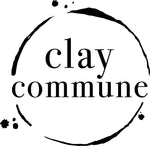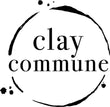Getting Started in Ceramics - What clay should you use.
This blog post is relevant for all potters but especially for the person who is just getting started in ceramics.
The information in this post will save you time, money and possibly a little heartache and should give you a direction in which clay to choose and work with.
When choosing a clay body ( type of clay ) to work with as a beginner there are several factors that you must take into consideration and each of these factors will influence what type of clay you can and should use.
There are many different clay types and each clay type will have a different maximum firing temperature, some examples are listed below ( these are the general firing temperatures that are done in the majority of studios but there are many more.)
Earthenware 1080c
Midfire 1200-1220c
Stoneware 1260-1280c
Porcelain 1280-1300c
What are you making?
If you are wanting to make specific items sometimes it is far better to use a type of clay that is more suitable for that purpose, an example of this is cups, cups and kitchenware are generally made from either stoneware clay or mid fire clay. ( predominantly stoneware or porcelain in Australia )
How are you making it?
Some clay bodies ( clay body = type of clay ) are better for hand building and some are better for wheel throwing and if you are wanting to try your hand at slip casting you'll need a liquified clay for pouring into your molds. Some clays can be used for both hand building and wheel throwing but generally a specific clay will better suited to one rather than both.
If you use a wheel throwing clay for hand building purposes you may have trouble constructing your final piece, most hand builders are using a fairly groggy clay - this makes it a lot easier to work with and your work will retain its shape a lot easier, if you were to try wheel throwing with a specifically designed hand building clay it would be difficult as a beginner and this is why we generally use a clay that is purpose built for this.
What do you want you finished piece to look like?
The look of the clay changes from each stage. If we were to look at Keanes Stoneware 33 in particular, when the clay is fresh out of the bag its a nice mocha brown colour, once bisque fired the clay has a beautiful pink hue, due to the iron content of the clay and once fully fired to 1280c the colour is gorgeous light brown with specs of iron throughout. It is important to look at the totally fired clay as what is visible in the bag isn't what the clay looks like once fired fully.
What is vitrification?
Vitrification of clay basically refers to the clay turning from clay into a final solid structure or solidification.
The capability of the kiln where you are firing your work will also influence what clay you can use, for example if the kiln where you are firing your work only reaches 1100c you will not be able to completely vitrifie either midfire or stoneware clays , meaning they will not reach solidification.
When I have someone come into the shop who is generally starting out with ceramics I find that they have a look in mind of the final piece that they are wishing to create or they have seen a post on instagram that they would like to replicate. The hard part of replicating that product is knowing all of the variables that exist with that final piece, and there are many.
My suggestion in working with a clay when starting out is choosing a clay that is forgiving and works well with construction ( the making of the piece ).
Dont choose a clay that is hard to throw on a wheel when starting out , choose something purpose built for wheel throwing.
Wheel throwing
We start people off with Keanes Stoneware 5 or Keanes Stoneware 33 and they are both great clays for the beginner on the wheel.
Hand Building
With hand building we generally have a few options depending on what the desired finish is of the final piece and how large the pot is.
Keanes White Raku is always a popular clay for the hand builder - its very easy to work with and has good joining properties and is a crisp white.
Keanes 5B is great and has a good grog content making it way easier to make larger forms.
Feeneys BRT is very popular however you've got to be a little careful of glaze fit and at the higher temps it sticks to the kiln shelves so placing biscuits under your pieces is a must
Keanes Special K - I love this clay for hand building - white and crisp in color it makes great slabs and has an awesome finish and also has good joining properties.
I sincerely hope that you've enjoyed my 1st blog and Im hoping that I can keep you entertained with a new blog regularly from now on. If there is a particular subject you would like information on or you have a blog suggestion please email me at info@claycommune.com.au and I will try my best.


Yesterday I visited Clay Commune for the first time. Thanks for the advice given on earthenware and mid fired clays.
Regards, Ray
Leave a comment